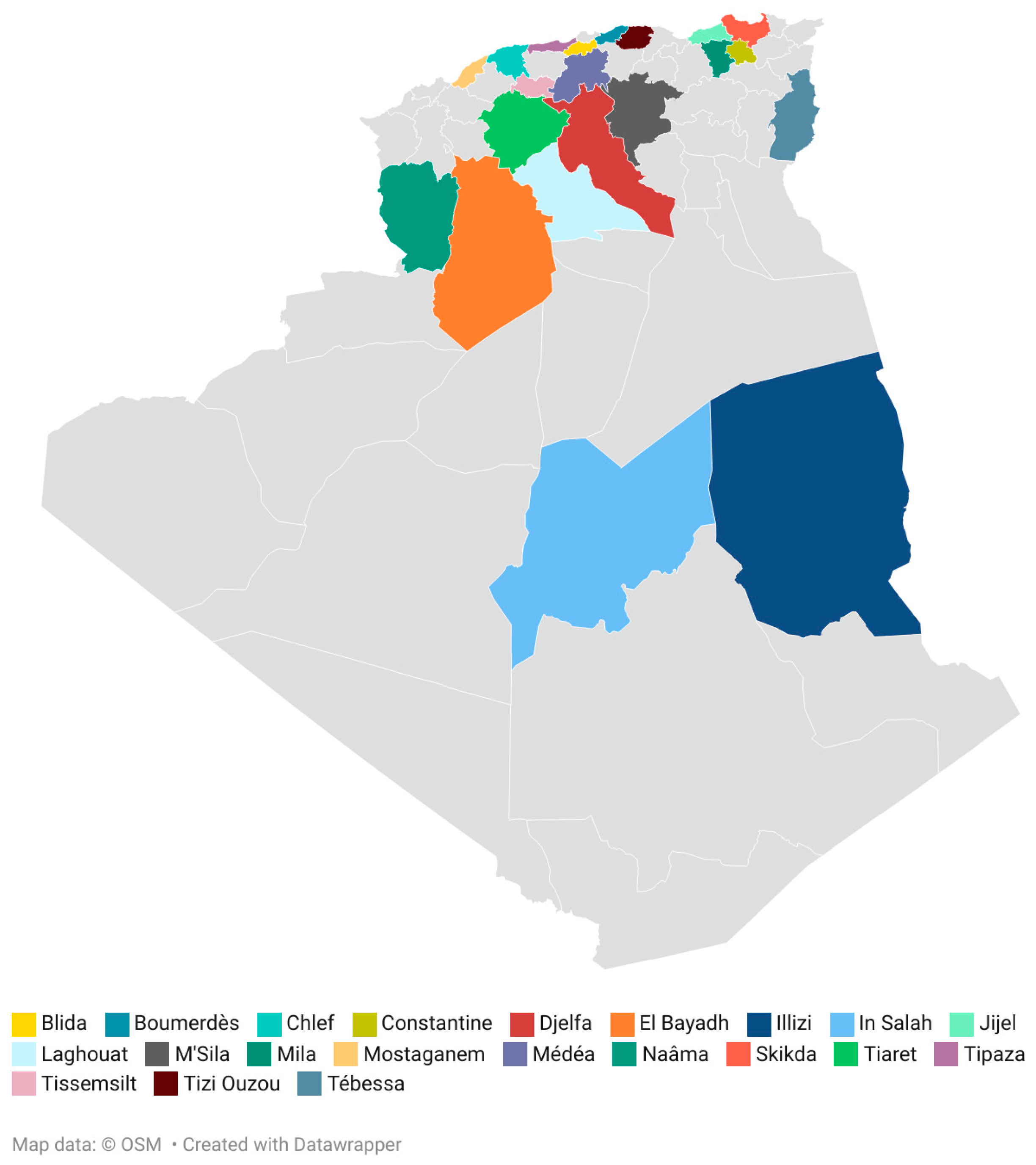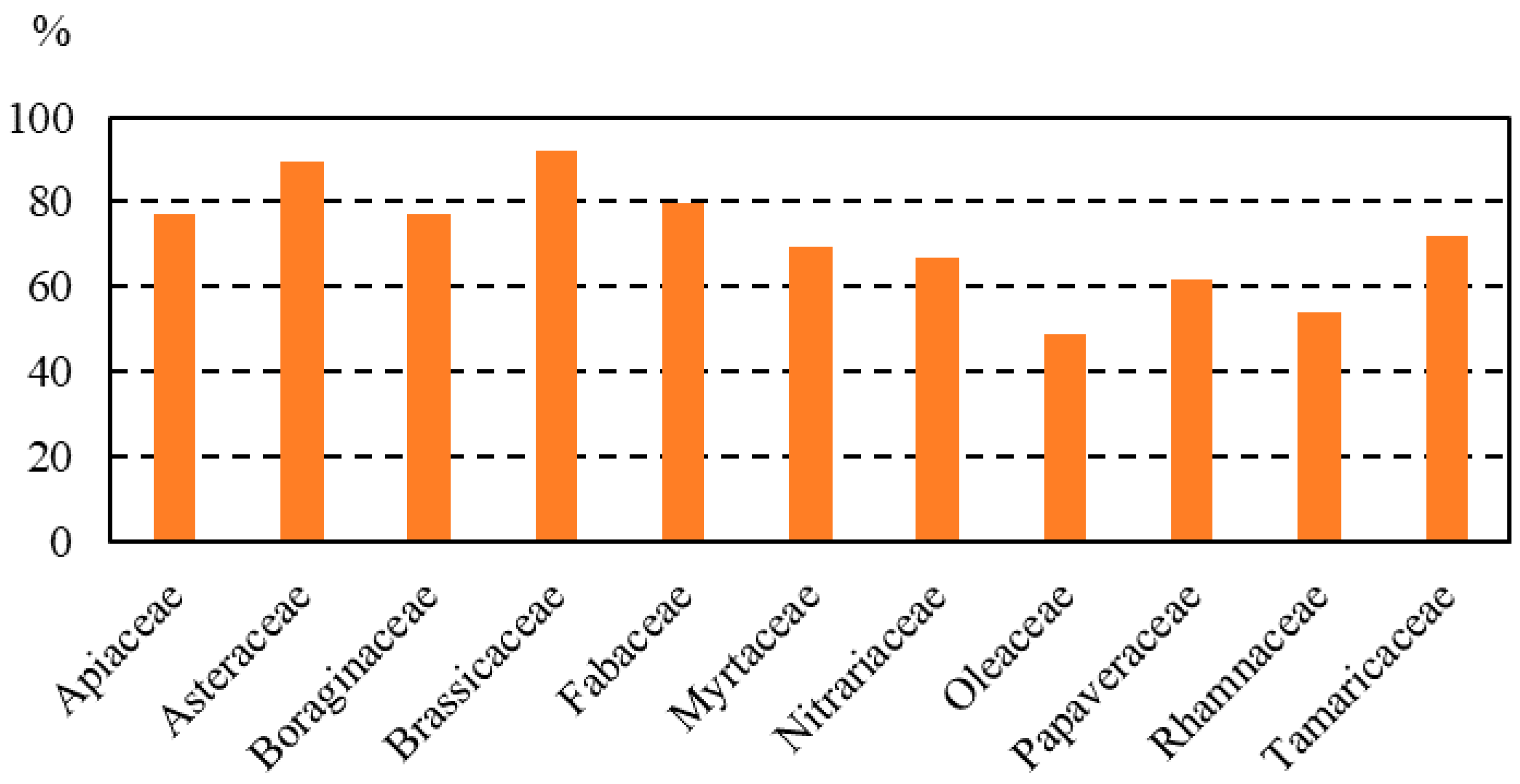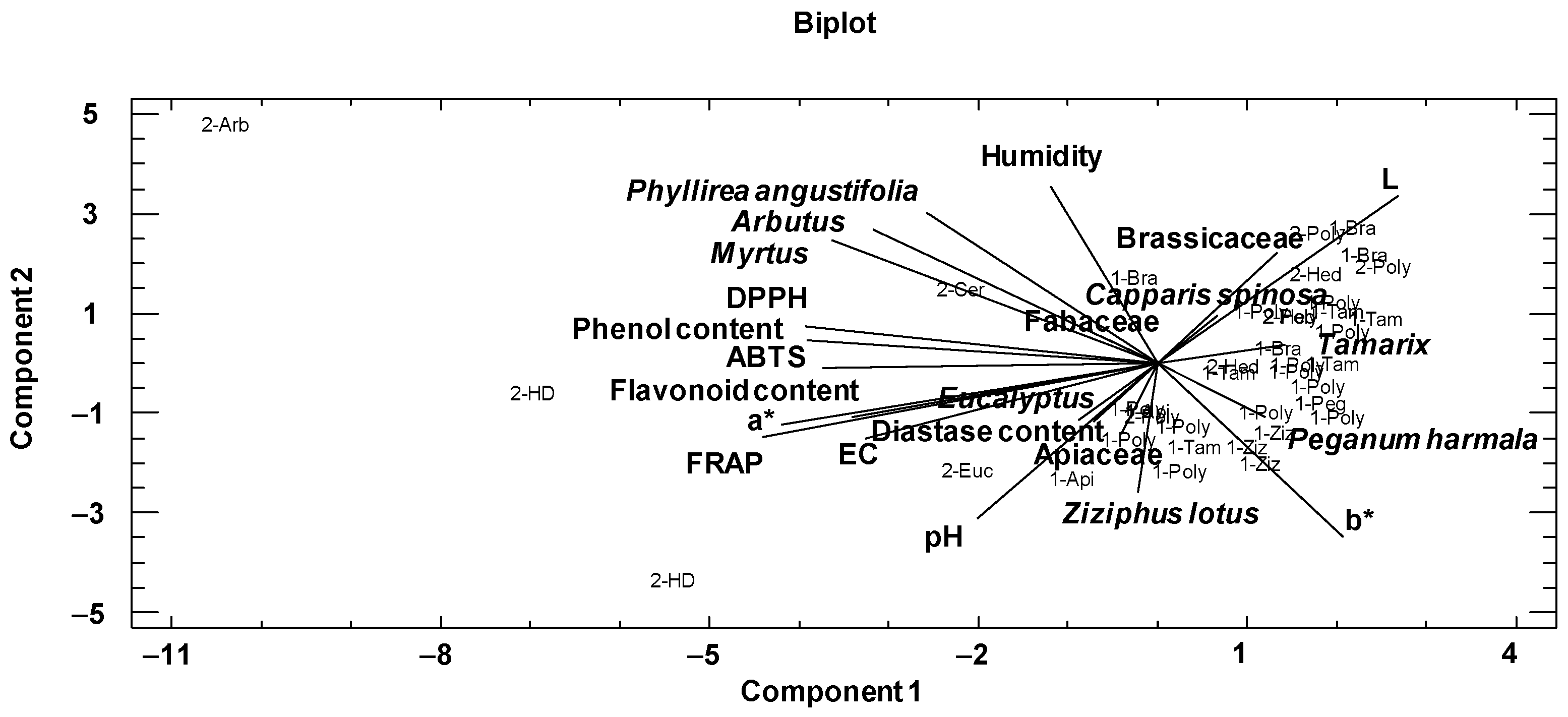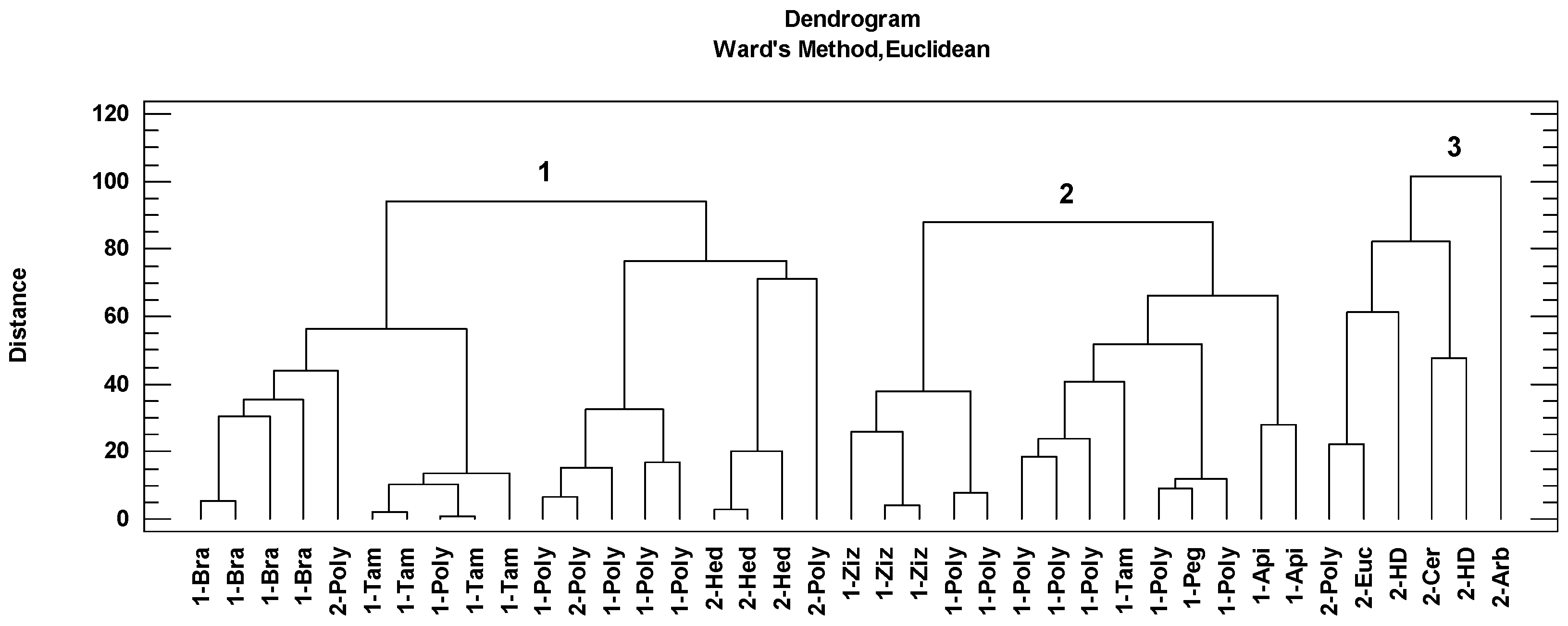The Contribution of Botanical Origin to the Physicochemical and Antioxidant Properties of Algerian Honeys
Abstract
1. Introduction
2. Materials and Methods
2.1. The Geographical Origin of the Honey Samples
2.2. Melissopalynological Analyses
2.3. The Determination of the Main Physicochemical Parameters and Color
2.4. The Determination of Total Phenolic and Flavonoid Contents
2.5. The Determination of Antioxidant Activity
2.5.1. Free Radical Scavenging Activity (DPPH)
2.5.2. ABTS Radical Scavenging Assay
2.5.3. Ferric Reducing/Antioxidant Power Assay (FRAP Assay)
2.6. Statistical Analyses
3. Results and Discussion
3.1. The Botanical Origin of Honey Samples
3.2. Physicochemical Parameters and Color
3.3. Total Phenolic and Flavonoid Contents and Antioxidant Activity
3.4. The Influence of Botanical and Geographical Origins on the Physicochemical Properties of the Analyzed Algerian Honeys through a Multivariate Statistical Approach
Supplementary Materials
Author Contributions
Funding
Institutional Review Board Statement
Informed Consent Statement
Data Availability Statement
Acknowledgments
Conflicts of Interest
References
- Wang, H.; Lantao, L.; Xiaohui, L.; Weidong, B.; Gengsheng, X.; Gongliang, L. Composition, Functional Properties and Safety of Honey. J. Sci. Food Agric. 2023, 103, 6767–6779. [Google Scholar] [CrossRef] [PubMed]
- Otmani, A.; Amessis-Ouchemoukh, N.; Birinci, C.; Yahiaoui, S.; Kolayli, S.; Rodríguez-Flores, M.S.; Ouchemoukh, S. Phenolic Compounds and Antioxidant and Antibacterial Activities of Algerian Honeys. J. Food Biosci. 2021, 42, 101070. [Google Scholar] [CrossRef]
- Kivima, E.; Tanilas, K.; Martverk, K.; Rosenvald, S.; Timberg, L.; Laos, K. The composition, physicochemical properties, antioxidant activity, and sensory properties of Estonian honeys. Foods 2021, 10, 511. [Google Scholar] [CrossRef] [PubMed]
- Makhloufi, C.; Kerkvliet, J.D.; D’albore, G.R.; Choukri, A.; Samar, R. Characterization of Algerian honeys by palynological and physico-chemical methods. Apidologie 2010, 41, 509–521. [Google Scholar] [CrossRef]
- Zerrouk, S.; Boughediri, L.; Seijo, M.C.; Fallico, B.; Arena, E.; Ballistreri, G. Pollen spectrum and physicochemical attributes of sulla (Hedysarum coronarium) honeys of Médéa region (Algeria). Alban J. Agric. Sci. 2013, 12, 511–517. [Google Scholar]
- Nakib, R.; Ghorab, A.; Ouelhadj, A.; Rodríguez-Flores, S.; Escuredo, O.; Bensouici, C.; Seijo, M.C. Chemometric evaluation of antioxidant activity and α-amylase inhibition of selected monofloral honeys from Algeria. J. Apic. Res. 2021, 1–11. [Google Scholar] [CrossRef]
- Zerrouk, S.; Bahloul, R. Palynological and physicochemical properties of multifloral honey produced in some regions of Algeria. J. Apic. Res. 2023, 62, 345–354. [Google Scholar] [CrossRef]
- Latifa, H.; Mouna, B.; Arezki, M. Ziziphus lotus and Euphorbia bupleuroides Algerian honeys. World Appl. Sci. J. 2013, 24, 1536–1543. [Google Scholar]
- Ouchemoukh, S.; Louaileche, H.; Schweitzer, P. Physicochemical characteristics and pollen spectrum of some Algerian honeys. Food Control 2007, 18, 52–58. [Google Scholar] [CrossRef]
- Homrani, M.; Escuredo, O.; Rodríguez-Flores, M.S.; Fatiha, D.; Mohammed, B.; Homrani, A.; Seijo, M.C. Botanical origin, pollen profile, and physicochemical properties of Algerian honey from different bioclimatic areas. Foods 2020, 9, 938. [Google Scholar] [CrossRef]
- Ghorab, A.; Rodríguez-Flores, M.S.; Nakib, R.; Escuredo, O.; Haderbache, L.; Bekdouche, F.; Seijo, M.C. Sensorial, melissopalynological and physico-chemical characteristics of honey from babors kabylia’s region (Algeria). Foods 2021, 10, 225. [Google Scholar] [CrossRef]
- Nakib, R.; Rodríguez-Flores, M.S.; Escuredo, O.; Ouelhadj, A.; Seijo, M.C. Retama sphaerocarpa, Atractylis serratuloides and Eruca sativa honeys from Algeria: Pollen dominance and volatile profiling (HS-SPME/GC–MS). Microchem. J. 2022, 174, 107088. [Google Scholar] [CrossRef]
- Zerrouk, S.; Seijo, M.C.; Escuredo, O.; Rodríguez-Flores, M.S. Characterization of Ziziphus lotus (jujube) honey produced in Algeria. J. Apic. Res. 2018, 57, 166–174. [Google Scholar] [CrossRef]
- Lobo, V.; Patil, A.; Phatak, A.; Chandra, N. Free radicals, antioxidants and functional foods: Impact on human health. Pharm. Rev. 2010, 4, 118. [Google Scholar] [CrossRef] [PubMed]
- Brown, J.E.; Rice-Evan, C.A. Luteolin-rich Artichoke extract protects low density lipoprotein from oxidation in vitro. Free Radic. Res. 1998, 29, 247–255. [Google Scholar] [CrossRef] [PubMed]
- Cianciosi, D.; Forbes-Hernández, T.Y.; Afrin, S.; Gasparrini, M.; Reboredo-Rodriguez, P.; Manna, P.P.; Battino, M. Phenolic compounds in honey and their associated health benefits: A review. Molecules 2018, 23, 2322. [Google Scholar] [CrossRef] [PubMed]
- Puścion-Jakubik, A.; Borawska, M.H.; Socha, K. Modern methods for assessing the quality of bee honey and botanical origin identification. Foods 2020, 9, 1028. [Google Scholar] [CrossRef] [PubMed]
- Al-Farsi, M.; Al-Amri, A.; Al-Hadhrami, A.; Al-Belushi, S. Color, flavonoids, phenolics and antioxidants of Omani honey. Heliyon 2018, 4, e00874. [Google Scholar] [CrossRef]
- Vela, L.; De Lorenzo, C.; Pérez, R.A. Antioxidant capacity of Spanish honeys and its correlation with polyphenol content and other physicochemical properties. J. Sci. Food Agric. 2007, 87, 1069–1075. [Google Scholar] [CrossRef]
- Dżugan, M.; Tomczyk, M.; Sowa, P.; Grabek-Lejko, D. Antioxidant activity as biomarker of honey variety. Molecules 2018, 23, 2069. [Google Scholar] [CrossRef]
- Ben Amor, S.; Mekious, S.; Allal Benfekih, L.; Abdellattif, M.H.; Boussebaa, W.; Almalki, F.A.; Kawsar, S.M. Phytochemical Characterization and Bioactivity of Different Honey Samples Collected in the Pre-Saharan Region in Algeria. Life 2022, 12, 927. [Google Scholar] [CrossRef] [PubMed]
- Perna, A.; Simonetti, A.; Intaglietta, I.; Sofo, A.; Gambacorta, E. Metal content of southern Italy honey of different botanical origins and its correlation with polyphenol content and antioxidant activity: Honey: Metal and polyphenol contents. Int. J. Food Sci. Technol. 2012, 47, 1909–1917. [Google Scholar] [CrossRef]
- Haderbache, L.; Mohammedi, A. Characterization and Chemometrics Based-Approach to Classify Some Algerian Blossom Honeys. J. Agric. Sci. Technol. A 2014, 4, 576–584. [Google Scholar]
- Se, K.W.; Wahab, R.A.; Yaacob, S.N.S.; Ghoshal, S.K. Detection techniques for adulterants in honey: Challenges and recent trends. J. Food Comp. Anal. 2019, 80, 16–32. [Google Scholar] [CrossRef]
- Wu, L.; Du, B.; Vander-Heyden, Y.; Chen, L.; Zhao, L.; Wang, M.; Xue, X. Recent advancements in detecting sugar-based adulterants in honey–A challenge. TrAC Trends Anal. Chem. 2017, 86, 25–38. [Google Scholar] [CrossRef]
- Pavlešić, T.; Poljak, S.; Ostojić, D.M.; Lučin, I.; Reynolds, C.A.; Kalafatovic, D.; Martinović, L.S. Mint (Mentha spp.) Honey: Analysis of the Phenolic Profile and Antioxidant Activity. Food Technol. Biotechnol. 2022, 60, 509–519. [Google Scholar] [CrossRef]
- Louveaux, J.; Maurizio, A.; Vorwohl, G. Methods of melissopalynology. Bee World 1978, 59, 139–157. [Google Scholar] [CrossRef]
- Rodríguez-Flores, M.S.; Escuredo, O.; Míguez, M.; Seijo, M.C. Differentiation of oak honeydew and chestnut honeys from the same geographical origin using chemometric methods. Food Chem. 2019, 297, 124979. [Google Scholar] [CrossRef]
- Bogdanov, S.; Martin, P.; Lullmann, C. Harmonized Methods of the International Honey Commission. Apidologie 1997, 28(Extra Issue), 1–59. Available online: https://www.ihc-platform.net/ihcmethods2009.pdf (accessed on 10 January 2022).
- Singleton, V.L.; Orthofer, R.; Lamuela-Raventos, R.M. Analysis of total phenols and other oxidation substrates and antioxidants by means of Folin-Ciocalteu reagent. Methods Enzymol. 1999, 299, 152–178. [Google Scholar]
- Arvouet-Grand, A.; Vennat, B.; Pourrat, A.; Legret, P. Standardization of propolis extract and identification of principal constituents. J. Pharm. Belg. 1994, 49, 462–468. [Google Scholar]
- Brand-Williams, W.; Culivier, M.E.; Berset, C. Use of a free radical method to evaluate antioxidant activity. LWT-Food Sci. Technol. 1995, 28, 25–30. [Google Scholar] [CrossRef]
- Re, R.; Pellegrini, N.; Proteggente, A.; Pannala, A.; Yang, M.; Rice-Evans, C. Antioxidant activity applying an improved ABTS radical cation decolorization assay. Free Radic. Biol. Med. 1999, 26, 1231–1237. [Google Scholar] [CrossRef] [PubMed]
- Benzie, I.F.; Strain, J.J. The ferric reducing ability of plasma (FRAP) as a measure of “antioxidant power”: The FRAP assay. Anal. Biochem. 1996, 239, 70–76. [Google Scholar] [CrossRef] [PubMed]
- Codex Alimentarius Commission. Revised Codex Standard for Honey, Codex STAN 12-1981, Rev.1 (1987), Rev.2 2001. Available online: http://www.fao.org/input/download/standards/310/cxs_012e.pdf (accessed on 10 January 2022).
- Terrab, A.; Díez, M.J.; Heredia, F.J. Characterisation of Moroccan Unifloral Honeys by Their Physicochemical Characteristics. Food Chem. 2002, 79, 373–379. [Google Scholar] [CrossRef]
- Bouddine, T.; Laaroussi, H.; Bakour, M.; Guirrou, I.; Khallouki, F.; Mazouz, H.; Hajjaj, H.; Hajji, L. Organic Honey from the Middle Atlas of Morocco: Physicochemical Parameters, Antioxidant Properties, Pollen Spectra, and Sugar Profiles. Foods 2022, 11, 3362. [Google Scholar] [CrossRef] [PubMed]
- Naman, M.; Faid, M.; El Adlouni, C. Microbiological and physico-chemical properties of Moroccan honey. Int. J. Agric. Biol. 2005, 7, 773–776. [Google Scholar]
- Boussaid, A.; Chouaibi, M.; Rezig, L.; Hellal, R.; Donsì, F.; Ferrari, G.; Hamdi, S. Physicochemical and bioactive properties of six honey samples from various floral origins from Tunisia. Arab. J. Chem. 2018, 11, 265–274. [Google Scholar] [CrossRef]
- Manzanares, A.B.; García, Z.H.; Galdón, B.R.; Rodríguez, E.R.; Romero, C.D. Physicochemical characteristics of minor monofloral honeys from Tenerife, Spain. LWT-Food Sci. Technol. 2014, 55, 572–578. [Google Scholar] [CrossRef]
- Zaidi, H.; Ouchemoukh, S.; Amessis-Ouchemoukh, N.; Debbache, N.; Pacheco, R.; Serralheiro, M.L.; Araujo, M.E. Biological properties of phenolic compound extracts in selected Algerian honeys—The inhibition of acetylcholinesterase and α-glucosidase activities. Eur. J. Integr. Med. 2019, 25, 77–84. [Google Scholar] [CrossRef]
- Do Nascimento, K.S.; Sattler, J.A.G.; Macedo, L.F.L.; González, C.V.S.; de Melo, I.L.P.; da Silva Araújo, E.; de Almeida-Muradian, L.B. Phenolic compounds, antioxidant capacity and physicochemical properties of Brazilian Apis mellifera honeys. LWT-Food Sci. Technol. 2018, 91, 85–94. [Google Scholar] [CrossRef]
- Scholz, M.B.D.S.; Quinhone Júnior, A.; Delamuta, B.H.; Nakamura, J.M.; Baudraz, M.C.; Reis, M.O.; Bianchini, F.P. Indication of the geographical origin of honey using its physicochemical characteristics and multivariate analysis. J. Food Sci. Technol. 2020, 57, 1896–1903. [Google Scholar] [CrossRef]
- Nayik, N.; Nanda, V. A chemometric approach to evaluate the phenolic compounds, antioxidant activity and mineral content of different unifloral honey types from Kashmir, India. LWT-Food Sci. Technol. 2016, 74, 504–513. [Google Scholar] [CrossRef]
- Crăciun, M.E.; Parvulescu, O.C.; Donise, A.C.; Dobre, T.; Stanciu, D.R. Characterization and classification of Romanian acacia honey based on its physicochemical parameters and chemometrics. Sci. Rep. 2020, 10, 20690. [Google Scholar] [CrossRef]
- Makhloufi, C.; Kerkvliet, J.; Schweitzer, P. Characterisation of Some Monofloral Algerian Honeys by Pollen Analysis. Grana 2015, 54, 156–166. [Google Scholar] [CrossRef]
- Zerrouk, S.; Seijo, M.C.; Boughediri, L.; Escuredo, O.; Rodríguez-Flores, M.S. Palynological characterisation of Algerian honeys according to their Geographical and botanical origin. Grana 2014, 53, 147–158. [Google Scholar] [CrossRef]
- Ulloa, P.A.; Miguel, M.; Brigas, A.F. Physicochemical parameters and bioactive compounds of Strawberry Tree (Arbutus unedo L.) Honey. J. Chem. 2015, 2015, 602792. [Google Scholar] [CrossRef]
- Von Der Ohe, W.; Persano Oddo, L.; Piana, M.L.; Morlot, M.; Martin, P. Harmonized methods of melissopalynology. Apidologie 2004, 35, S18–S25. [Google Scholar] [CrossRef]
- Jurič, A.; Brčić-Karačonji, I.; Gašić, U.; Milojković-Opsenica, D.; Prđun, S.; Bubalo, D.; Kopjar, N. Protective effects of Arbutus unedo L. honey in the alleviation of irinotecan-induced cytogenetic damage in human lymphocytes—An in vitro study. Int. J. Mol. Sci. 2023, 24, 1903. [Google Scholar] [CrossRef]
- Wesołowska, M.; Dżugan, M. The use of the Photochem device in evaluation of antioxidant activity of Polish honey. Food Anal. Methods 2017, 10, 1568–1574. [Google Scholar] [CrossRef]
- Bahloul, R.; Zerrouk, S.; Chaibi, R. Pollen analysis of honey from Laghouat region (Algeria). Grana 2022, 61, 471–480. [Google Scholar] [CrossRef]
- El-Wahed, A.A.A.; Rashwan, E.H.; AlAjmi, M.F.; Khalifa, S.A.M.; Saeed, A.; Zhao, C.; Naggar, Y.A.; Guo, Z.; Musharraf, S.G.; Wang, K.; et al. Sidr Honeys Physical and Chemical Characterization, a Comprehensive Approach through LC-MS/MS, NMR, and GC-MS Analysis. Separations 2023, 10, 372. [Google Scholar] [CrossRef]
- Beretta, G.; Granata, P.; Ferrero, M.; Faccino, F.M. Standardization of antioxidant properties of honey by a combination of spectrophotometric/fluorimetric assays and chemometrics. Anal. Chim. Acta 2005, 533, 185–191. [Google Scholar] [CrossRef]




| Geographical Area | Number of Samples | Climate Type | Latitude | Longitude |
|---|---|---|---|---|
| Illizi | 1 | Arid | 26°28′59″ N | 8°28′00″ E |
| Constantine | 1 | Mediterranean | 36°21′54″ N | 6°36′52″ E |
| Djelfa | 10 | Semi-arid | 34°40′22″ N | 3°15′46″ E |
| Laghouat | 4 | Arid | 33°47′59″ N | 2°51′54″ E |
| Boumerdès | 1 | Mediterranean | 36°45′37″ N | 3°28′20″ E |
| El-Bayadh | 2 | Semi-arid | 33°40′49″ N | 1°01′13″ E |
| In Salah | 1 | Arid | 27°11′36″ N | 2°27′38″ E |
| Tébessa | 1 | Semi-arid | 35°24′15″ N | 8°07′27″ E |
| M’Sila | 4 | Semi-arid | 35°42′20″ N | 4°32′30″ E |
| Tissemsilt | 1 | Semi-arid | 35°36′25″ N | 1°48′38″ E |
| Médéa | 2 | Mediterranean | 36°15′51″ N | 2°45′14″ E |
| Tiaret | 1 | Semi-arid | 35°22′15″ N | 1°19′01″ E |
| Naâma | 1 | Semi-arid | 33°16′00″ N | 0°19′00″O |
| Blida | 1 | Mediterranean | 36°28′12″ N | 2°49′39″ E |
| Mostaganem | 2 | Semi-arid | 35°55′52″ N | 0°05′21″ E |
| Tipaza | 1 | Mediterranean | 36°35′22″ N | 2°26′50″ E |
| Tizi-Ouzou | 1 | Mediterranean | 36°42′42″ N | 4°02′45″ E |
| Chlef | 1 | Semi-arid | 36°09′54″ N | 1°20′04″ E |
| Jijel | 1 | Mediterranean | 36°49′13″ N | 5°46′00″ E |
| Mila | 1 | Mediterranean | 36°27′01″ N | 6°15′51″ E |
| Skikda | 1 | Mediterranean | 36°52′34″ N | 6°54′33″ E |
| Family | Pollen Type | P | R | I | A | D |
|---|---|---|---|---|---|---|
| Apiaceae | Coriandrum | 17.9 | - | 5.1 | - | 2.6 |
| Bupleurum | 5.1 | 2.6 | - | - | 2.6 | |
| Daucus carota t | 20.5 | 2.6 | 2.6 | 2.6 | - | |
| Pimpinella anisum t | 5.1 | 10.3 | 5.1 | - | - | |
| Eryngium campestre t | 25.6 | 7.7 | 2.6 | - | - | |
| Ferula communis t | 2.6 | 2.6 | 2.6 | - | - | |
| Asteraceae | Centaurea t | 20.5 | 15.4 | 20.5 | - | - |
| Atractylis | 25.6 | 10.3 | 10.3 | - | - | |
| Anthemis t | 20.5 | 5.1 | 10.3 | - | - | |
| Aster t | 10.3 | 7.7 | 2.6 | - | - | |
| Scorzonera t | 20.5 | 5.1 | 2.6 | - | - | |
| Galactites t | 15.4 | 2.6 | 2.6 | - | - | |
| Arctium t | 7.7 | 2.6 | 2.6 | - | - | |
| Boraginaceae | Echium | 25.6 | 30.8 | 17.9 | 2.6 | - |
| Brassicaceae | Brassica napus t | 5.1 | 12.8 | 38.5 | 25.6 | 10.3 |
| Capparaceae | Capparis spinosa | - | - | - | 2.6 | - |
| Ericaceace | Arbutus | - | - | 2.6 | - | - |
| Euphorbiaceae | Euphorbia t | 15.4 | 5.1 | 2.6 | - | - |
| Fabaceae | Hedysarum coronarium | 10.3 | 15.4 | 2.6 | 5.1 | 10.3 |
| Ceratonia siliqua | - | 2.6 | - | - | 2.6 | |
| Genista t | 17.9 | 23.1 | 15.4 | 5.1 | - | |
| Astragalus | 2.6 | 2.6 | 2.6 | - | - | |
| Lythraceae | Punica granatum | 7.7 | - | 7.7 | - | - |
| Myrtaceae | Eucalyptus | 46.2 | 5.1 | 7.7 | 5.1 | 5.1 |
| Myrtus | 7.7 | - | 5.1 | 2.6 | - | |
| Nitrariaceae | Peganum harmala | 7.7 | 12.8 | 33.3 | 10.3 | 2.6 |
| Oleaceae | Olea europaea | 17.9 | 20.5 | 7.7 | 2.6 | - |
| Phyllirea angustifolia | - | - | 5.1 | - | - | |
| Papaveraceae | Papaver rhoeas t | 25.6 | 20.5 | 15.4 | - | - |
| Rhamnaceae | Ziziphus lotus | 15.4 | 10.3 | 10.3 | 7.7 | 10.3 |
| Rosaceae | Prunus t | 17.9 | 5.1 | 2.6 | - | - |
| Tamaricaceae | Tamarix | 10.3 | 2.6 | 17.9 | 28.2 | 12.8 |
| Mean | SD | Maximum | Minimum | |
|---|---|---|---|---|
| Humidity (%) | 17.1 | 2.4 | 23.0 | 13.0 |
| pH | 4.1 | 0.3 | 5.1 | 3.5 |
| Electrical conductivity (mS/cm) | 0.291 | 0.165 | 0.743 | 0.104 |
| Diastase content | 26.3 | 13.3 | 58.1 | 6.0 |
| Color (mm Pfund) | 66.4 | 26.0 | 149.0 | 22.5 |
| L | 86.0 | 5.1 | 97.4 | 71.2 |
| a* | −2.3 | 4.9 | 17.1 | −7.3 |
| b* | 22.8 | 9.5 | 40.4 | −2.2 |
| Phenolic content (mg GAE/100 g) | 81.8 | 82.1 | 464.1 | 19.7 |
| Flavonoid content (mg QE/100 g) | 3.1 | 2.1 | 11.0 | 0.3 |
| DPPH (%) | 24.4 | 20.1 | 87.1 | 3.0 |
| ABTS (%) | 18.8 | 12.2 | 51.7 | 3.9 |
| FRAP (µmol Trolox/g) | 87.6 | 38.1 | 237.2 | 50.7 |
| Number of Components | ||||||||
|---|---|---|---|---|---|---|---|---|
| 1 | 2 | 3 | 4 | 5 | 6 | 7 | 8 | |
| Eigenvalue | 6.77 | 3.22 | 1.90 | 1.76 | 1.35 | 1.31 | 1.26 | 1.04 |
| Variance (%) | 29.44 | 13.98 | 8.28 | 7.63 | 5.88 | 5.69 | 5.47 | 4.50 |
| Cumulative variance (%) | 29.44 | 43.43 | 51.71 | 59.34 | 65.22 | 70.90 | 76.38 | 80.88 |
| Component weights for each variable | ||||||||
| Physicochemical variables | ||||||||
| Humidity | −0.09 | 0.37 | −0.06 | −0.19 | 0.25 | −0.05 | −0.18 | −0.22 |
| pH | −0.16 | −0.32 | 0.29 | −0.01 | 0.29 | 0.00 | 0.15 | 0.02 |
| Electrical conductivity (EC) | −0.26 | −0.16 | 0.15 | −0.16 | −0.14 | −0.24 | −0.14 | −0.12 |
| Diastase content | −0.06 | −0.12 | 0.28 | 0.48 | −0.16 | −0.03 | −0.10 | −0.16 |
| L | 0.21 | 0.34 | 0.07 | 0.24 | 0.01 | −0.13 | 0.04 | 0.00 |
| a* | −0.33 | −0.13 | −0.16 | 0.00 | 0.06 | 0.05 | −0.06 | 0.22 |
| b* | 0.17 | −0.36 | 0.04 | −0.24 | −0.06 | 0.09 | −0.11 | −0.22 |
| Phenol content | −0.31 | 0.05 | −0.19 | 0.25 | −0.06 | 0.10 | 0.04 | 0.24 |
| Flavonoid content | −0.27 | −0.11 | −0.15 | 0.20 | −0.13 | 0.25 | −0.09 | 0.16 |
| DPPH | −0.31 | 0.08 | −0.08 | 0.07 | 0.18 | −0.19 | −0.10 | 0.10 |
| ABTS | −0.30 | −0.01 | −0.01 | 0.23 | 0.15 | 0.18 | −0.04 | −0.10 |
| FRAP | −0.35 | −0.15 | 0.01 | −0.02 | 0.16 | −0.07 | −0.03 | −0.03 |
| Pollen variables | ||||||||
| Apiaceae | −0.03 | −0.14 | −0.17 | −0.09 | 0.26 | 0.47 | 0.45 | −0.37 |
| Arbutus | −0.25 | 0.28 | 0.28 | −0.19 | −0.17 | 0.09 | 0.09 | −0.07 |
| Brassicaceae | 0.11 | 0.23 | 0.11 | 0.25 | 0.43 | 0.07 | −0.11 | 0.07 |
| Capparis spinosa | 0.05 | 0.10 | −0.07 | −0.08 | 0.17 | −0.20 | 0.44 | 0.50 |
| Eucalyptus | −0.07 | −0.12 | −0.15 | −0.32 | 0.24 | −0.31 | −0.40 | 0.03 |
| Fabaceae | −0.05 | 0.06 | −0.51 | 0.16 | −0.41 | −0.21 | 0.04 | −0.26 |
| Myrtus | −0.29 | 0.25 | 0.20 | −0.14 | −0.20 | 0.08 | 0.05 | −0.02 |
| Peganum harmala | 0.10 | −0.11 | 0.07 | −0.26 | −0.30 | 0.32 | −0.12 | 0.48 |
| Phyllirea angustifolia | −0.20 | 0.31 | 0.27 | −0.23 | −0.14 | 0.05 | 0.14 | −0.10 |
| Tamarix | 0.11 | 0.04 | 0.24 | 0.16 | 0.03 | 0.30 | −0.44 | 0.06 |
| Ziziphus lotus | −0.02 | −0.27 | 0.37 | 0.18 | −0.08 | −0.39 | 0.26 | 0.01 |
| Cluster 1 | Cluster 2 | Cluster 3 | |
|---|---|---|---|
| Physicochemical variables | |||
| Humidity (%) | 18.1 b | 15.0 a | 18.9 b |
| pH | 3.9 a | 4.2 b | 4.3 a |
| Electrical conductivity (mS/cm) | 0.207 b | 0.313 b | 0.505 a |
| Diastase content | 22.7 | 32.6 | 26.5 |
| L | 88.8 a | 84.0 b | 81.4 b |
| a* | −4.7 b | −2.5 b | 6.0 a |
| b* | 21.8 | 27.0 a | 15.8 b |
| Phenol content (mg GAE/100 g) | 49.4 b | 74.1 b | 202.2 a |
| Flavonoid content (mg QE/100 g) | 2.3 b | 3.3 | 5.4 a |
| DPPH (%) | 18.6 b | 14.4 b | 65.8 a |
| ABTS (%) | 15.6 b | 16.4 b | 34.5 a |
| FRAP (µmol Trolox/g) | 67.3 b | 84.6 b | 158.8 a |
| Pollen variables (%) | |||
| Apiaceae | 1.7 b | 14.6 a | 1.2 b |
| Arbutus | 0 | 0 | 1.0 |
| Brassicaceae | 23.8 a | 7.2 b | 3.0 b |
| Capparis spinosa | 1.9 a | 0 b | 0 b |
| Eucalyptus | 1.3 b | 1.7 b | 24.7 a |
| Fabaceae | 16.9 | 7.8 | 22.5 |
| Myrtus | 0 b | 0.2 b | 4.6 a |
| Peganum harmala | 4.3 b | 15.1 a | 0.1 b |
| Phyllirea angustifolia | 0.3 | 0 | 1.7 |
| Tamarix | 23.8 | 15.6 | 0.1 |
| Ziziphus lotus | 2.0 b | 18.8 a | 9.5 |
Disclaimer/Publisher’s Note: The statements, opinions and data contained in all publications are solely those of the individual author(s) and contributor(s) and not of MDPI and/or the editor(s). MDPI and/or the editor(s) disclaim responsibility for any injury to people or property resulting from any ideas, methods, instructions or products referred to in the content. |
© 2024 by the authors. Licensee MDPI, Basel, Switzerland. This article is an open access article distributed under the terms and conditions of the Creative Commons Attribution (CC BY) license (https://creativecommons.org/licenses/by/4.0/).
Share and Cite
Harbane, S.; Escuredo, O.; Saker, Y.; Ghorab, A.; Nakib, R.; Rodríguez-Flores, M.S.; Ouelhadj, A.; Seijo, M.C. The Contribution of Botanical Origin to the Physicochemical and Antioxidant Properties of Algerian Honeys. Foods 2024, 13, 573. https://doi.org/10.3390/foods13040573
Harbane S, Escuredo O, Saker Y, Ghorab A, Nakib R, Rodríguez-Flores MS, Ouelhadj A, Seijo MC. The Contribution of Botanical Origin to the Physicochemical and Antioxidant Properties of Algerian Honeys. Foods. 2024; 13(4):573. https://doi.org/10.3390/foods13040573
Chicago/Turabian StyleHarbane, Sonia, Olga Escuredo, Yasmine Saker, Asma Ghorab, Rifka Nakib, María Shantal Rodríguez-Flores, Akli Ouelhadj, and María Carmen Seijo. 2024. "The Contribution of Botanical Origin to the Physicochemical and Antioxidant Properties of Algerian Honeys" Foods 13, no. 4: 573. https://doi.org/10.3390/foods13040573
APA StyleHarbane, S., Escuredo, O., Saker, Y., Ghorab, A., Nakib, R., Rodríguez-Flores, M. S., Ouelhadj, A., & Seijo, M. C. (2024). The Contribution of Botanical Origin to the Physicochemical and Antioxidant Properties of Algerian Honeys. Foods, 13(4), 573. https://doi.org/10.3390/foods13040573









